assamintro.com
History and Biography Read in Assamese

Rabindranath Tagore Biography in Assamese। কবিগুৰু ৰবীন্দ্রনাথ ঠাকুৰ
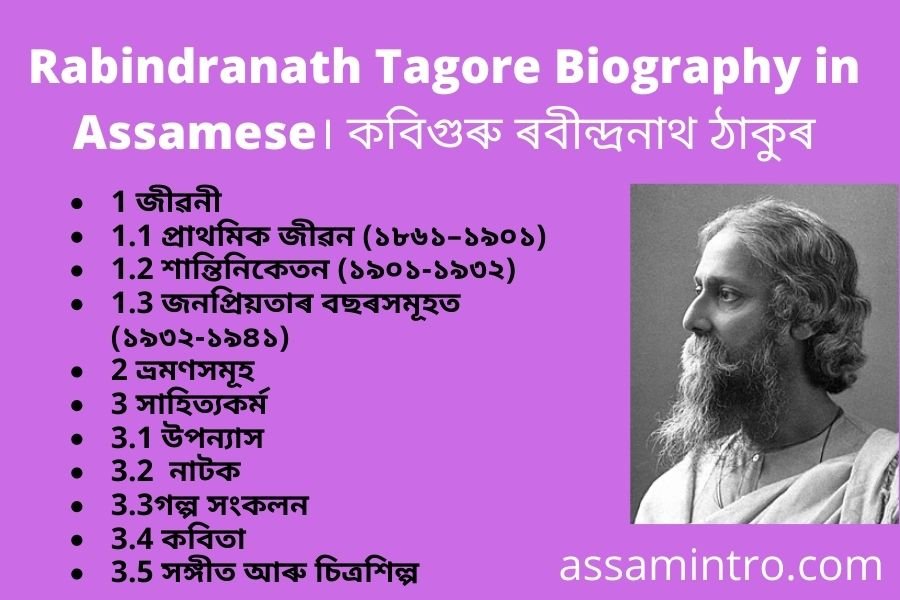
Table of Contents
কবিগুৰু ৰবীন্দ্রনাথ ঠাকুৰ Rabindranath Tagore Biography in Assamese
প্ৰথমবাৰৰ বাবে ভাৰতবৰ্ষৰ সাহিত্যক বিশ্ব সাহিত্যত চিনাকি কৰাই দিয়া মহান ব্যক্তিগৰাকীয়েই হৈছে কবিগুৰু ৰবীন্দ্রনাথ ঠাকুৰ । নিজৰ কাব্য প্রতিভাৰে আজিৰ পৰা এশবছৰ পূর্বেই বিশ্বৰ সবাতােতকৈ শ্রেষ্ঠ সন্মান কঢ়িয়াই আনিবলৈ সক্ষম হ’ল কলকতাৰ ঠাকুৰ পৰিয়ালৰ চতুর্থ সন্তান ৰবীন্দ্রনাথে।
যিসময়ত ব্ৰিটিছে ভাৰতবৰ্ষখন শাসন কৰি আছিল, যিসময়ত তেওঁলােকৰ পৰিয়ালে ব্রিটিছৰ আজ্ঞামতে কাম কৰি আছিল, সেই সময়তে ব্রিটিছৰ বিৰুদ্ধেও তেওঁ মহাত্মা গান্ধীৰ লগত সহমত প্ৰকাশ কৰিছিল।
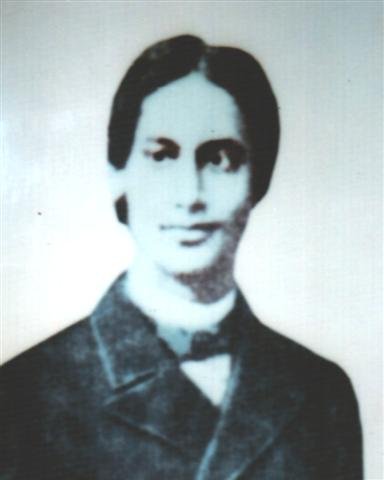
কবিতাৰ ঝংকাৰেৰে এদিন বিশ্ববীণাৰ ভঁৰত মুখৰিত হৈ উঠিছিল, ছন্দময় জীৱনৰ গান। সুৰৰ লহৰে লহৰে উচ্ছলিত হৈ উঠিছিল প্ৰাণৰ উচ্ছ্বাস; উচ্ছল অনুভূতিৰ পাৰ ভাঙি ভাঙি বৈ আহিছিল লাস্যময়ী ভাৱ-মন্দাকিনী। সুন্দৰৰ পূজাৰ সেই মধু লগনত এজন শান্ত, সৌম্য, গুৰু-গম্ভীৰ বাণী পূজাৰীয়ে ষােড়শােপচাৰে অর্ঘ্য নিবেদন কৰিছিল বাণী মন্দিৰত অন্তৰৰ আৱেগ ঢালি। ভাৰতীয় প্রজ্ঞা আৰু মনীষাৰ পৰাকাষ্ঠাৰ প্রতিভূ সেইজন আছিল ৰবীন্দ্রনাথ ঠাকুৰ যিজনে স্বীয় প্রতিভাৰে সমগ্ৰ বিশ্বৰ সর্বশ্রেষ্ঠ মনীষীসকলৰ মাজত নিজকে “স্বে মহিম্নি” ৰূপে প্রতিষ্ঠা কৰিবলৈ সমৰ্থ হৈছিল। বহুমুখী প্রতিভাৰ অধিকাৰী এই ঋষিতুল্য পুৰুষজনৰ মৃত্যুঞ্জয়ী গৌৰৱ গাথা আজি বিশ্ব বিনন্দিত। Rabindranath Tagore Biography in Assamese
বংশ পৰিচয়, জন্ম
কলিকতাৰ জোৰাসাঁকো ঠাকুৰ পৰিয়াল এটা মহিমামণ্ডিত নাম। উনবিংশ শতিকাৰ সাহিত্য ৰচনা বিচিত্রা আৰু সংস্কৃতিৰ পীঠস্থান জোৰাসাঁকো। কাব্য কবিতা, শিল্প-সংস্কৃতিৰ চৰ্চাৰপৰা আৰম্ভ কৰি জাতীয় জাগৃতিৰ উদ্বোধনলৈকে ঠাকুৰ পৰিয়ালৰ অৱদানৰ ইতিহাস ভাৰতীয় সামাজিক জগতৰ বুৰঞ্জীত চিৰদিন গৌৰৱােজ্জ্বল হৈ ৰ’ব। বিশেষকৈ মহর্ষি দেবেন্দ্রনাথ ঠাকুৰৰ ঔপনিষদিক সাধনা, প্রাচ্য-পাশ্চাত্য সংস্কৃতিৰ অভূতপূর্ব সমন্বয় আৰু স্বদেশপ্রেমৰ নৱেন্মেষে ঠাকুৰ পৰিয়ালত সৃষ্টি কৰিছিল মহামিলনৰ এক মহান তীর্থ। সেই মহান তীর্থভূমিত মহর্ষি দেবেন্দ্রনাথ ঠাকুৰে ১৮৬১ চনৰ ৬ মে’ তাৰিখে লাভ কৰিছিল এটি দেৱ শিশু যাৰ হাঁহিত উদ্ভাসিত হৈ উঠিছিল অনির্বচনীয় গৰিমাৰ জ্যোতি। সেই শিশুটিয়েই আছিল ৰবীন্দ্রনাথ।
শৈশৱ আৰু শিক্ষা
শৈশৱতে মাতৃহাৰা হােৱা ৰবীন্দ্রনাথে পিতৃৰ অসীম স্নেহ আৰু ভ্ৰাতৃসকলৰ আদৰ-আপ্যায়নৰ মাজত বর্ধিত হৈ মাতৃৰ অভাৱ বৰকৈ অনুভৱ কৰিব নােৱাৰিলেও মাতৃহাৰা শিশুৰ সকলােখিনি শৈশৱ আৰু শিক্ষা কাৰুণ্যই তেওঁৰ জীৱনলৈ আহিছিল। পৰিয়ালৰ উন্নত শিক্ষা-দীক্ষা, পৰিমার্জিত সাংস্কৃতিক চেতনা আৰু দেবেন্দ্রনাথ ঠাকুৰৰ গভীৰ ধর্ম বিশ্বাসে ৰবীন্দ্রনাথক প্ৰৱলভাৱে প্ৰভাৱান্বিত কৰিছিল। তদুপৰি পিতৃৰ লগত নানা ঠাই ভ্ৰমণ কৰি ফুৰি প্ৰকৃতি আৰু ইয়াৰ সৌন্দৰ্যৰ প্রতি প্রৱলভাৱে আকৃষ্ট হােৱা ৰবীন্দ্ৰনাথৰ জীৱনত গভীৰভাৱে পৰিছিল প্রেম, প্রকৃতি, সৌন্দর্য আৰু স্বদেশ প্ৰেমৰ মহান অনুভূতিৰ জ্যোতির্ময় প্রভাৱ।
তেওঁ প্রথমে অৰিয়েণ্টেল ছেমিনাৰীত আৰু তাৰ পাছত নর্মাল স্কুল, বেংগল একাডেমী আৰু ছেণ্ট জেভিয়ার্চ স্কুলত শিক্ষা লাভ কৰে। কিন্তু বিদ্যালয়-জীৱনৰ সীমাবদ্ধতা আৰু নির্দিষ্ট ধৰা বন্ধা পাঠ্যক্ৰমৰ ঠেক গণ্ডীৰ মাজত তেওঁৰ মুক্ত মন আৰু মুক্ত চিন্তাই স্বাধীনতা হেৰুওৱা পিঞ্জৰাবদ্ধ পখীৰ অসহায় বেদনা অনুভৱ কৰিব ধৰিলে। গতিকে দেউতাকে গৃহ-শিক্ষকৰ যােগেদিয়েই তেওঁক নানা বিষয়ৰ শিক্ষা দিয়ায়। তেওঁ পিতৃৰপৰাই সংস্কৃত আৰু ভাৰতীয় দর্শন সাহিত্যৰ আৰু মধ্যম ভ্রাতৃ সত্যেন্দ্রনাথৰপৰা ইংৰাজী সাহিত্যৰ বিশাল ভাণ্ডাৰৰ দি দর্শন লাভ কৰে।
সােতৰ বছৰ বয়সত ৰবীন্দ্রনাথে অধ্যয়নৰ কাৰণে বিলাতলৈ যায়। বিলাতত থকা কালত পাশ্চত্য জীৱন, সাহিত্য-সংস্কৃতিৰ লগত তেওঁৰ নিবিড় পৰিচয় ঘটে। তদুপৰি পাশ্চাত্য সংগীতৰ সুৰৰ ঝংকাৰে তেওঁৰ প্রাণ বীণৰ তাঁৰত তােলে বিপুল মূচ্ছনা।

কাব্য চৰ্চা আৰু সাহিত্যিক অৱদান
ৰবীন্দ্রনাথে ন বছৰ বয়সৰপৰাই নিৰৱচ্ছিন্নভাৱে কাব্য চর্চা কৰিবলৈ ধৰে। তেৰ বছৰ বয়সতে তেওঁৰ প্রথম কবিতা “তত্ত্ব বােধিনী”–কাকতত প্রকাশিত হয়। তাৰ পাছৰেপৰা “ভাৰতী”,“সাধনা”— আদি কাকতততা নিত্য নতুন কবিতা প্রকাশিত হ’বলৈ ধৰে আৰু লগে লগে তেওঁৰ কাব্য চর্চা আৰু স্বতঃস্ফূর্ত প্রতিভাই বিকাশৰ পথত দ্রুতগতিৰে আগ বাঢ়ে। ৰবীন্দ্ৰনাথৰ অজস্র সাহিত্যিক অৱদান কাব্যই ছন্দৰ মন্দাকিনী ধাৰা ধৰাৰ বুকুলৈ নমাই আনি অনিন্দ্যসুন্দৰ সুৰৰ ঝংকাৰেৰে ভাৰতীয় কাব্য জগতত হেন্দোলনি তােলে। প্ৰাণৰ আকুল উচ্ছাসেৰে মানুহৰ সুখ-দুখ, হাঁহি-আনন্দ, ব্যথা-বেদনাৰ গভীৰতম অনুভূতিক জীৱন্ত ৰূপত ৰূপায়িত কৰিছে তেওঁৰ বাক্যৰ মাজেদি। বনফুল কাব্যত প্রস্ফুটিত হ’বলৈ আৰম্ভ কৰা কবিতা কুসুমৰাজি সন্ধ্যা সংগীত, প্রভাত সংগীত, ছবি ও গান, কড়ি ও কোমল, ভানু সিংহ ঠাকুৰেৰ পদাৱলী, মানসী, সােণাৰ তৰী আদি কাব্যত বেদনা-বিধুৰ জীৱনৰ ছন্দ মধুৰ গান পুষ্প হৈ তাৰ সৌৰভেৰে জগৎ বিমােহিত মহুয়া, কৰি তােলে। ৰমক-জমক কাব্য-ফুলনিত আকাশ-প্রদীপ, বলাকা, পলাতকা, পূৰৱী, বন বাণী, পৰিশেষ, পুনশ্চ, শেষ সপ্তক, শ্যামলী, নৱজাতক, চানাই, জন্মদিনে, শেষ লেখা আদিৰ সৌৰভ মিশ্ৰিত হৈ সৌন্দর্য আৰু সৌৰভৰ অমৃত নিস্যন্দিনী ছন্দধাৰা সীমাহীন দিগন্তৰ কল্পলােকলৈ গতি। কৰিবলৈ ধৰে অনন্ত জ্যোতিৰে জ্যোতিষ্মন হৈ। কবিৰ মানসপটত বাজি উঠা ছন্দৰ সুৰ হৈ চিত্রা, চৈতালি, কণিকা, কল্পনা, কথা ও কাহিনী, নৈবেদ্য, খেয়া, গীতাঞ্জলি আৰু গীতালীৰ গীতিমালাৰে মানুহৰ হিয়া মন্দিৰত নিবিড় আনন্দৰ উচ্ছল জোৱাৰৰ সৃষ্টি কৰিলে। বাল্মীকি প্রতিভা, শ্যামা, চণ্ডালিকা আদি তেখেতৰ সুকুমাৰ মন-কাননত সৃষ্টি হােৱা অনবদ্য গীতিনৃত্য নাট্য। বাল্মীকি প্রতিভা তেখেতৰ প্ৰাচ্য পাশ্চাত্য সঙ্গীত সাধনাৰ শ্রেষ্ঠতম ফলশ্রুতি।
তেখেতৰ উপন্যাসৰাজিৰ ভিতৰত বৌ-ঠাকুৰাণীৰ হাট, গােৰা, যােগাযােগ, ঘৰে বাইৰে, চতুৰংগ আদি উল্লেখযোেগ্য।
ৰক্ত কৰবী, বিসর্জন, ৰাজা, মালিনী আদি শ্রেষ্ট নাট্য সাহিত্য।
সাহিত্যকৰ্ম
ৰবীন্দ্ৰনাথৰ সকলোতকৈ প্ৰভাৱশালী সাহিত্য হৈছে তেখেতৰ গান আৰু কবিতাবোৰ। চুটিগল্প, প্ৰবন্ধ, ভ্ৰমণকাহিনী আৰু নাটক ৰচনাতো তেখেত সিদ্ধহস্ত আছিল। গান আৰু কবিতাৰ পিছতে তেখেতৰ আটাইতকৈ প্ৰভাৱশালী ৰচনা হ’ল চুটিগল্প। তেখেতক বাংলা ভাষাৰ চুটিগল্পৰ প্ৰতিষ্ঠাতা বুলি গণ্য কৰা হয়। তেখেতৰ ৰচনাৰ ছান্দসিক, আশাবাদী আৰু গীতিধৰ্মী ৰূপে সহজেই সকলোকে আকৰ্ষম কৰে। সাধাৰণ বাঙালীৰ জীৱনধাৰা আছিল তেখেতৰ ৰচনাৰ প্ৰধান উপজীৱ্য।
ৰবীন্দ্ৰনাথে প্ৰথম প্ৰথম ভাতৃ জ্যোতিৰিন্দ্ৰনাথ ঠাকুৰ অনূদিত মলিয়েৰৰ বুৰ্জোৱা (Le Bourgeois Gentilhomme) নাটৰ প্ৰধান চৰিত্ৰৰ ৰূপায়ণৰ মাজেৰে আত্মপ্ৰকাশ কৰে। ২০ বছৰ বয়ষত তেওঁ প্ৰথম নাটক “বাল্মিকী” ৰচনা কৰে। ইয়াত ডকাইত ৰত্নাকৰে কেনেকৈ নিজৰ জীৱনদৰ্শন সলনি কৰি বাল্মিকী হৈ ৰামায়ণ ৰচনা কৰে তাক প্ৰতীয়মান কৰা হৈছে। ইয়াত তেওঁ বিভিন্ন নাট্যশৈলী আৰু ভাৱৰ প্ৰকাশ ঘটাইছে, যেনে কীৰ্তনৰ ব্যৱহাৰ, মাতাল গানত ঐতিহ্যবাহী বৃটিচ আৰু আইৰিচ লোকসংগীতৰ সূৰৰ সংকলন।
১৮৯০ চনত ৰবীন্দ্ৰনাথে বিসৰ্জন ৰচনা কৰেন যাক অনেকে তেওঁৰ ৰচিত সৰ্বশ্ৰেষ্ঠ নাটক বুলি বিবেচনা কৰে।তেওঁৰ পাচৰ ফালৰ নাটকবোৰত ৰূপকে বেচি প্ৰাধান্য পাইছে। এনে এখন উল্লেখযোগ্য নাটক “ডাকঘৰ”। ইয়াত এজন সৰু ল’ৰাই নিজৰ দৈনন্দিন জীৱনৰ পৰা মুক্তি বিচাৰে আৰু অৱশেষত “শুই পৰে” (মৃত্যুৰ ৰূপক/প্ৰতীক)। সাৰ্ব জনীন আৱেদনসম্পন্ন “ডাকঘৰ”ৰ গল্পই ইউৰোপত যথেষ্ট সঁহাৰি পাইছিল। ৰবীন্দ্ৰনাথৰ ভাষাত ল’ৰাটোৰ শুই পৰাৰ ৰূপকটোৱে “শুই পৰা” ৰূপকটোৱে “জাগতিক স্তুপীকৃত সম্পদ আৰু প্ৰচলিত বিশ্বাস”ৰ পৰা “আধ্যাত্মিক মুক্তি” সূচাইছে। আন এখন উল্লেখযোগ্য নাট “চন্দালিকা” এটা প্ৰাচীন বৌদ্ধ কিংবদন্তী লৈ গঢ়ি উঠিছে। ইয়াত গৌতম বুদ্ধৰ শিষ্য আনন্দই এগৰাকী আদিবাসী ছোৱালীৰ পৰা পানী খুজি খোৱাৰ কথা বৰ্নোৱা হৈছে। ৰবীন্দ্ৰনাথৰ বিখ্যাত নাটক “ৰক্তকৰবী”ত এজন লোভী ৰজাৰ কথা কোৱা হৈছে। ধনৰ লোভত তেওঁ প্ৰজাসকলক খনিত কাম কৰিবলৈ বাধ্য কৰে। নায়িকা নন্দিনীয়ে প্ৰজাসকলক একগোট কৰে আৰু এই অত্যাচাৰৰ অন্ত ঘটায়। তেওঁৰ অন্যান্য উল্লেখযোগ্য নাটক হৈছে “চিত্ৰাংগদা”, “ৰাজা”, মায়াৰ খেলা আদি। ৰবীন্দ্ৰনাথৰ নৃত্যপ্ৰধান নাটসমূহক “ৰবীন্দ্ৰ নৃত্যনাট্য” বুলি জনা যায়। তেখেতে ৰচনা কৰা
নাটকসমূহ হ’ল-
নোবেল বটাঁ লাভ
মানৱ জীৱনৰ বিভিন্ন সমস্যা, ঘটনা, পৰিৱেশ আদিক লৈ ৰচিত তেখেতৰ গল্পসমূহ গল্প-গুচ্ছ নামেৰে কেইবা খণ্ডতে প্রকাশিত হৈছে। জীৱন-স্মৃতি তেখেতৰ আত্মজীৱনীমূলক গ্রন্থ। এই গ্ৰন্থত নােবেল বঁটা লাভ তেখেতৰ জীৱন-দর্শন বর্ণিত হৈছে। সাহিত্য জগতৰ এনে এটি দিশ নাই, যত ৰবীন্দ্ৰনাথৰ সুনিপুণ হাতৰ পৰশ পৰা নাই। ৰবীন্দ্রনাথ দার্শনিক আৰু আধ্যাত্মিক প্রতিভাৰ শ্রেষ্ঠতম নিদর্শন গীতাঞ্জলি। গীতাঞ্জলিৰ ইংৰাজী সংস্কৰণে তেওঁক বিশ্বৰ শ্ৰেষ্ঠ কবি ৰূপে প্রতিষ্ঠিত কৰে আৰু তাৰ বাবেই তেওঁ ১৯১৩ চনত সাহিত্যৰ নােবেল বঁটা লাভ কৰে। Rabindranath Tagore Biography in Assamese
ৰবীন্দ্ৰ সন্দ্বীত
প্রাচ্য আৰু পাশ্চত্যৰ সংগীত সাধনাই ৰবীন্দ্রনাথক শ্রেষ্ঠ সংগীতজ্ঞ ৰূপেও প্রতিষ্ঠা কৰে। ৰবীন্দ্ৰ সন্দ্বীত তেওঁৰ স্বৰচিত গীতসমূহত নিজেই সুৰ সংযােজনা কৰি এক অভিনৱ ঐতিহ্যৰ সৃষ্টি কৰে আৰু সেয়ে ৰবীন্দ্রসংগীত ৰূপে অভিহিত হয়।
অভিনেতা ৰবীন্দ্ৰনাথ
আবৃত্তি আৰু অভিনয়তাে তেওঁৰ প্রতিভা আছিল বিচক্ষণ। স্বৰচিত নাটকত বিশিষ্ট ভূমিকাত অভিনেতা অৱতীৰ্ণ হৈ চমকপ্রদ অভিনয়েৰে মঞ্চ জগতত নৱ-আলােড়ন সৃষ্টি কৰিছিল। ৰবীন্দ্রনাথ বিশেষকৈ বাল্মীকি প্রতিভা’ নাটকত নাম ভূমিকাত আৰু ‘কাল মৃগয়া’ নাটকত অন্ধমুনিৰ ভাওত অৱতীৰ্ণ হৈব্বীন্দ্রনাথে নাট্য-প্রতিভাৰ যি দক্ষতা প্রদর্শন কৰিছিল তাৰ তুলনা পাবলৈ টান।
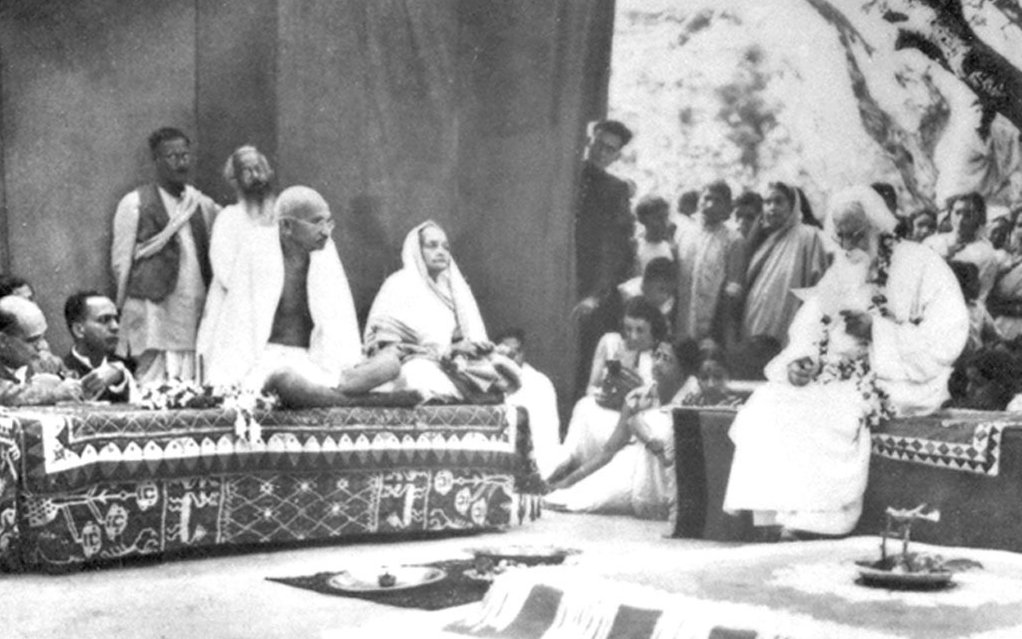
স্বদেশ প্রেমিক ৰবীন্দ্রনাথ
ৰবীন্দ্রনাথ যে কেৱল কালজয়ী কবি, সাহিত্যিক, নাট্যকাৰ আৰু শিল্পীয়েই আছিল, এনে নহয়, তেওঁ হাড়ে-হিমজুৱে স্বদেশ প্রেমিক। ১৯০৫ চনৰ বংগভংগ আন্দোলনত সক্রিয় ভূমিকা গ্ৰহণ কৰা স্বদেশ প্রেমিক নাছিল যদিও কবিতা, প্রবন্ধ আৰু সংগীতৰ যােগেদিয়ে স্বদেশ প্ৰেমৰ অনুপ্ৰেৰণাৰে ৰবীন্দ্রনাথ দেশবাসীক উদ্বুদ্ধ কৰি তুলিছিল। অপূর্ব কাব্য সাধনাৰে দেশবাসীৰ স্বাধীনতাৰ আকাঙ্ক্ষাকে তেওঁ জীৱন্ত ৰূপ প্ৰদান কৰিছিল। ১৯১৭ চনৰ জালিয়ানৱালাবাগত স্বাধীনতাকামী ভাৰতীয়ৰ বুকুত গুলী বহুৱাই নৃশংস হত্যাকাণ্ডৰ সৃষ্টি কৰি ইংৰাজ চৰকাৰে যি বৰ্বৰ দমননীতি প্রদর্শন কৰিছিল, তাৰ প্ৰতিবাদত ৰবীন্দ্রনাথে “নাইট” উপাধি পৰিত্যাগ কৰি দেশপ্রেমিকতাৰ চৰম নিদর্শন প্রদর্শন কৰিছিল। ভাৰতৰ ৰাষ্ট্ৰীয় সংগীত “জনগণ মন অধিনায়ক”ৰবীন্দ্ৰনাথৰ দেশ-প্ৰেমৰ আন এক শ্রেষ্ঠ নিদর্শন। এই গৰাকী সংবেদনশীল কবি অতিশয় সমাজসচেতন আছিল আৰু য’তেই অন্যায়, অবিচাৰ শােষণ আদি দেখিছিল, তাতেই তেওঁ নির্ভীকভাৱে তাৰ বিৰুদ্ধে থিয় দিছিল।
বিশ্ব ভ্ৰমণ
ৰবীন্দ্রনাথ চীন, জাপান, ইন্দোনেছিয়া, ৰাছিয়া, পাৰস্য, ইউৰােপ, আমেৰিকা আদি দেশ ভ্রমণ কৰি ভাৰতৰ মর্যাদ বৃদ্ধি কৰিছিল। বিশ্বৰ দেশসমূহে তেওঁৰ প্ৰতি প্রদর্শন কৰা শ্রদ্ধাই ভাৰতৰ গৰিমাকে উজ্জ্বল কৰি তােলে।

সংগঠনমূলক কাম
এই গৰাকী বিশ্বৰ শ্রেষ্ঠ কবি প্রাচীন ভাৰতীয় শিক্ষাদৰ্শনৰ প্রতিভূ। মুক্ত আকাশৰ তলত, মুক্ত প্রকৃতিৰ উদাৰ পৰিৱেশত, অনুকূল মানসিক প্রবৃত্তিৰ বিকাশ সাধনাৰ যােগে লাভ কৰা শিক্ষাই, মানৱ জীৱন সর্বাংগসুন্দৰ কৰি গঢ়ি তােলাৰ একমাত্র উপায় বুলি কবিয়ে বিশ্বাস কৰে। বিদ্যালয়ৰ সংগঠনমূলক কাম সীমাবদ্ধতাৰ মাজত বাধ্যতামূলকভাৱে জাপি দিয়া শিক্ষাই শিশুৰ প্ৰবৃত্তিসমূহৰ

পূর্ণ বিকাশ সাধন কৰিব নামৰ ঠাইত শান্ত, নির্জন প্রাকৃতিক পৰিৱেশত প্রতিষ্ঠা কৰে “শান্তিনিকেতন”নামৰ আদর্শ বিদ্যালয়। কালক্ৰমত সিয়ে ‘বিশ্বভাৰতী’ নামে খ্যাত বিশ্ববিদ্যালয়ত পৰিণত হয়। তাৰ ওচৰতে দেশীয় কৃষি আৰু শিল্পৰ উৎকর্ষ সাধনৰ কাৰণে “শ্রীনিকেতন”নামৰ এটি প্রতিষ্ঠান স্থাপন কৰে। এই দুটি অনুষ্ঠান কবি গৰাকীৰ সাধনা, আদর্শ আৰু জীৱন দৰ্শনৰ মূর্ত প্রতীক।বীন্দ্রনাথে নােবেল বঁটাৰ এক লাখতকৈও অধিক টকাৰ সমস্তখিনি শান্তি নিকেতনৰ উন্নয়নৰ বাবেই ব্যয় কৰিছিল।
সত্য আৰু সুন্দৰৰ সাধক ৰবীন্দ্রনাথ আছিল প্রকৃতি আৰু মানৱপ্রেমী। “সুন্দৰৰ আৰাধনা জীৱনৰ খেল” এয়ে আছিল তেওঁৰ সংগীতৰ মর্মবাণী। “সত্যম্ শিবম্ সুন্দৰম”- এয়া আছিল সামৰণি তেওঁৰ দৰ্শনৰ মর্মবাণী। চিৰ সুন্দৰৰ অসীম সুন্দৰ প্ৰকৃতিৰ বুকুৰ ৰূপৰস-গন্ধ স্পৰ্শৰ মােহময়ী আকর্ষণ, সুখ-দুখ, ব্যথা-বেদনা, বিৰহ-মিলন, দয়া-ক্ষমা, কৰুণা, প্রেম-প্রীতিৰ মধুৰ বান্ধোন ছিন্ন কৰি, কেঁচা মাটিৰ চিত্তাকর্ষী গন্ধৰ টান এৰি থৈ কবিয়ে কোনাে দিনেই আঁতৰি যাব খােজা নাই। সেয়েহে আৱেগত কবিয়ে গাইছে
মৰিতে চাহি না আমি সুন্দৰ ভুবনে,
মানবেৰ মাঝে আমি বাঁচিবাৰে চাই।”
সুন্দৰৰ সাধনাৰ সুবিমল মন্দিৰত কবিয়ে সদায় দেখিছিল বিশ্ব মানৱৰ সেৱাৰ মংগলময় থলী। সবাৰ ওপৰে মনুস্ব, তাহাৰ ওপৰে সত্য নাই।”— এই মর্মবাণী কবিয়ে মর্মে মর্মে উপলব্ধি কৰিছিল। সেই বাবে কবিয়ে গভীৰ আৱেগ আৰু অনুভূতিৰে কৈছে
“মানুষেৰ আধিকাৰে বঞ্চিত কৰেছ যাৰে,
সন্মুখে দাঁড়ায়ে ৰেখে তবু কোলে দাও নাই স্থান;
মানুষেৰ পৰশেৰে প্রতিদিন ঠেকাইয়া দূৰে
ঘৃণা কৰিয়াছ তুমি মানুষেৰ প্রাণেৰ ঠাকুৰে
বিধাতাৰ ৰুদ্ৰৰােষে দুর্ভিক্ষেৰ দ্বাৰে বসে।
ভাগ কৰে খেতে হবে সকলেৰ সাথে অন্ন পান
অপমানে হতে হবে তাহাদেৰ সবাৰ সমান।”
এই সুন্দৰৰ সাধক, মানৱপ্রেমী, দার্শনিক কবি মহা মনীষীগৰাকী ১৯৪১ চনৰ ৭ আগষ্ট তাৰিখে পৰপাৰলৈ গমন কৰে; কেৱল বংগৰ নহয়, ভাৰতৰ নহয়, বিশ্বৰ এই মনীষীগৰাকীয়ে বিশ্ব-মানৱৰ হৃদয় সুকুমাৰ অনুভূতিৰে উদ্বুদ্ধ কৰি মানৱ সমাজক সুন্দৰৰ পৰা সুন্দৰতৰলৈ, খণ্ডতাৰপৰা পূর্ণতালৈ, অন্ধকাৰৰপৰা পােহৰলৈ, মৃত্যুৰপৰা অমৃতলােকলৈ, অনিত্যতাৰপৰা চিন্তনলৈ গতি কৰাৰ জ্যোতির্ময় পথ প্রদর্শন কৰি গৈছে। ৰবীন্দ্ৰ জ্যোতিৰ মাধুৰ্যৰে মাৱন-সমাজ মাধুৰিমাময় হৈ উঠক।
You also Read
- ভগৎ সিং ৰ জীৱনী
- মণিৰাম দেৱান
- নেতাজী সুভাষ চন্দ্ৰ বসু
- মহাত্মা গান্ধী
- শচীন ৰমেশ তেণ্ডুলকা Sachin Tendulkar Biography
- Rosona Bichitra by Dhormo Shing Deka
- Nobel Bata Bijaye Bharatiya by Bipul Kr. Dihinga
- Frenz, H. (editor) (1969), Rabindranath Tagore—Biography , Nobel Foundation, r কৰা হৈছে: 2009-11-26
- Robinson, A., “Rabindranath Tagore”, Encyclopædia Britannica , r কৰা হৈছে: 2009-11-26
- Abhijit Sarma Baruah …..
- Something I collected from Wikipedia
Learning, Awareness and Education is the purpose of this Blog/Website.
If any mistake or error please kindly inform us , thanks
4 thoughts on “ Rabindranath Tagore Biography in Assamese। কবিগুৰু ৰবীন্দ্রনাথ ঠাকুৰ ”
ইয়াত মূল কথা কিছুমান লিখা নাই,যেনে ৰবীন্দৰ নাথ ঠাকুৰেই কিয় নাইট উপাধি লোৱা নাছিল?
i updated soon
thanks for inform
Ketiya diba
Leave a Reply Cancel reply
Your email address will not be published. Required fields are marked *
Save my name, email, and website in this browser for the next time I comment.

ৰবীন্দ্ৰনাথ ঠাকুৰ | Rabindranath Tagore Biography
ৰবীন্দ্ৰনাথ ঠাকুৰ | Rabindranath Tagore Essay in Assamese | Biography of Rabindranath Tagore in Assamese | ৰবীন্দ্ৰনাথ ঠাকুৰ বিষয়ে জীৱনী | ৰবীন্দ্ৰনাথ ঠাকুৰ বিষয়ে ৰচনা | ৰবীন্দ্ৰনাথ ঠাকুৰৰ চমু পৰিচয়।
ঊনবিংশ শতিকাৰ মাজভাগৰ পৰা বিংশ শতিকাৰ প্ৰথম কালছোৱা আধুনিক বাংলা সাহিত্যৰ ৰবীন্দ্ৰ যুগ নামেৰে পৰিচিত। ৰবীন্দ্ৰনাথ ঠাকুৰ ( Rabindranath Tagore ) বহুমুখী প্ৰতিভাসম্পন্ন ব্যক্তি আছিল। তেওঁ একেধাৰে কবি, উপন্যাসিক, নাট্যকাৰ, গীতিকাৰ, গল্পকাৰ, প্ৰবন্ধকাৰ, চিত্ৰকৰ, দাৰ্শনিক, কন্ঠশিল্পী তথা অভিনেতা আছিল। কবিগুৰু, বিশ্বকবি, গুৰুদেৱ নামেৰে প্ৰসিদ্ধ ৰবীন্দ্ৰনাথ ঠাকুৰে বিশ্বৰ সাহিত্যৰ মানচিত্ৰত ভাৰতক নিজৰ দক্ষতাৰ জৰিয়তে স্থান দিছিল।

ৰবীন্দ্ৰনাথ ঠাকুৰ জীৱনী | Rabindranath Tagore Biography
Table of Contents
ৰবীন্দ্ৰনাথ ঠাকুৰ প্ৰাৰম্ভিক জীৱনী | Early Life of Rabindranath Tagore
কলিকতাৰ জোড়াসাঁকোৰ বিখ্যাত ঠাকুৰ পৰিয়ালত ১৮৬১ চনৰ ৭ মে’ তাৰিখে জন্মগ্ৰহণ কৰিছিল ৰবীন্দ্ৰনাথ ঠাকুৰে। পিতৃ মহৰ্ষি দেবেন্দ্ৰ নাথ ঠাকুৰ আৰু মাতৃ সাৰদা সুন্দৰী দেৱী ৰ পোন্ধৰটা সন্তানৰ ভিতৰত চৈধ্য নম্বৰ সন্তান আছিল ৰবীন্দ্ৰনাথ ঠাকুৰ। সামাজিক, সাংস্কৃতিক আৰু সাহিত্যৰ চৰ্চাৰ ক্ষেত্ৰত সমগ্ৰ ভাৰতৰ প্ৰেক্ষাপটত ৰবীন্দ্ৰনাথ ঠাকুৰৰ পৰিয়ালৰ অৱদান অনস্বীকাৰ্য্য। ৰবীন্দ্ৰনাথ ঠাকুৰৰ ককাক দ্বাৰকানাথে ধৰ্মীয় কু-সংস্কাৰ শেষ কৰি এক সংস্কাৰ সমাজ ব্যৱস্থা গঢ়ি তোলাৰ বাবে প্ৰচেষ্টা অব্যাহত ৰাখিছিল। অন্যহাতে ৰবীন্দ্ৰনাথ ঠাকুৰৰ পিতৃ দেবেন্দ্রনাথ ঠাকুৰেও ধৰ্মীয় আৰু সামাজিক ক্ষেত্ৰখনত সংস্কাৰ সাধন কৰিবলৈ অহোপুৰুষাৰ্থ কৰাৰ লগতে প্রাচ্য-পাশ্চাত্য সংস্কৃতিৰ অভূতপূর্ব সমন্বয় সাধন কৰিবলৈ প্ৰচেষ্টা অব্যাহত ৰাখিছিল।
ৰবীন্দ্ৰ নাথ ঠাকুৰ মানুহৰ একতাৰ ওপৰত পৰম বিশ্বাসী হোৱাৰ লগতে প্ৰকৃতিৰ প্ৰতিও তেওঁৰ আছিল গভীৰ প্ৰেম। বিশ্বৰ শ্ৰেষ্ঠ কবি আৰু বিশ্বৰ চিন্তাদূত হিচাপে অভিহিত বহুমুখী প্ৰতিভাৰ অধিকাৰী ৰবীন্দ্ৰনাথ ঠাকুৰে বঙলা সাহিত্যলৈ ৫২ খন কাব্য,৬০ খন নাটক, ১৩ খন উপন্যাস, ৯৫ এটা চুটি গল্প, ৩০০০ বিৰল চিত্ৰ, ২০০০ গীত, চিঠি আদিৰে যাউতি যুগীয়া অৱদান আগবঢ়াই। গুৰুত্বপূৰ্ণ কথা যে তেখেতে ভানুসিংহ ৰ ছদ্মনামেৰেও বিভিন্ন গীত, কবিতা ৰচনা কৰিছিল।
Also Read: অচ্যুত লহকৰ জীৱনী | Biography of Achyut Lahkar
ৰবীন্দ্ৰনাথ ঠাকুৰ সাহিত্যিক জীৱন | Literary Life of Rabindranath Tagore
ৰবীন্দ্ৰনাথ ঠাকুৰ আভিজাত্য, ঋষিপিতা দেবেন্দ্ৰনাথ ঠাকুৰৰ প্ৰভাৱ, স্বদেশী মনোভাৱ, সংযত সৌন্দৰ্যবোধ আৰু শিল্পৰুচীৰ মাজত ডাঙৰ দীঘল হৈছিল। পাৰিবাৰিক পৰিৱেশেই তেওঁৰ শিল্পী মন তথা কবি হৃদয় লাহে লাহে প্ৰস্ফুটিত হোৱাৰ বাবে অনুঘটকৰ দৰে কাম কৰিছিল। মাত্ৰ আঠ বছৰ বয়সৰ পৰাই ৰবীন্দ্ৰনাথ ঠাকুৰে কবিতা লিখিবলৈ আৰম্ভ কৰিছিল। ১৮৭৪ চনত তত্ত্ববোধিনী পত্ৰিকা ত প্ৰকাশিত ‘ অভিলাষ’ কবিতাটো তেওঁৰ প্ৰথম প্ৰকাশিত ৰচনা।
ইয়াৰ পৰৱৰ্তী সময়ত “ ভাৰতী ” , “ সাধনা ” — আদি কাকতত ৰবীন্দ্ৰনাথৰ নিত্য নতুন কবিতা প্রকাশিত পাইছিল।
কবিতা | Poems
ৰবীন্দ্ৰনাথ ঠাকুৰে ৰচনা কৰা কবিতা পুথি সমূহ হ’ল- ‘ কবিকাহিনী’ , ‘ বনফুল’ , ‘ ভগ্নহৃদয়’ , ‘ সন্ধ্যাসংগীত’ , ‘ প্ৰভাতসংগীত’ , ‘ ছবি ও গান’ , ‘ কড়ি ও কোমল’ , ‘ মানসী সোনাৰ তৰী’ ( ১৮৯৪ ), ‘ চিত্ৰা ‘( ১৮৯৬ ), ‘ চৈতালি’ ( ১৮৯৬ ), ‘ কল্পনা’ ( ১৯০০ ) আৰু ‘ ক্ষণিকা’ ( ১৯০০ ), ‘ নৈবেদ্য’ ( ১৯০১ ), ‘ খেয়া’ ( ১৯০৬ ), ‘ গীতাঞ্জলি’ ( ১৯১০ ), ‘ গীতিমাল্য’ ( ১৯১৪ ), ‘ গীতালি’ ( ১৯১৪ ), ‘ বলাকা’ ( ১৯১৬ ), ‘ পলাতকা’ ( ১৯১৮ ), ‘ পূৰবী’ ( ১৯২৫ ), ‘ মহুৱা’ ( ১৯২৯ ), ‘ ৰোগশয্যায়’ ( ১৯৪০ ), ‘ আৰোগ্য ‘( ১৯৪১ ), ‘ জন্মদিনে’ ( ১৯৪১ ), ‘ শেষ লেখা’ ( ১৯৪১ , মৰণোত্তৰ ভাবে প্ৰকাশিত ) ।
ইয়াৰ উপৰিও ঠাকুৰৰ দ্বাৰা প্ৰকাশিত চাৰিখন গদ্যকাব্য হ’ল- ‘ পুনশ্চ’ ( ১৯৩২ ), ‘ শেষ সপ্তক ‘( ১৯৩৫ ), ‘ পত্ৰপুট’ ( ১৯৩৬ ) আৰু ‘ শ্যামলী’ ( ১৯৩৬ ) ।
ৰবীন্দ্ৰনাথ ঠাকুৰৰ কবিতাত মানৱ হৃদয়ৰ বিষণ্ণতা, আনন্দ, মৰ্ত্যপ্ৰীতি আৰু মানৱপ্ৰেম,আধ্যাত্মিক চিন্তাৰ প্ৰাধান্য পৰিলক্ষিত হয়। ভাৱ-গভীৰতা,গতিধৰ্মিতা,প্ৰকৃতিপ্ৰেম,সৌন্দৰ্য চেতনা হ’ল তেওঁৰ কবিতাৰ প্ৰধান বৈশিষ্ট্য । ইয়াৰ ওপৰিও ৰবীন্দ্ৰনাথ ঠাকুৰে তেওঁৰ কবিতাত প্ৰাচীন সাহিত্যেৰ দুৰূহতাৰ পৰিবৰ্তে সহজ আৰু সৰস কাব্যৰচনাৰ আঙ্গিক গ্ৰহণ কৰিছিল। ইয়াৰ ওপৰিও ১৯৩০-ৰ দশকত কিছু পৰীক্ষামূলক ৰচনাৰ মাধ্যমেদি বাংলা সাহিত্যত আধুনিকতা আৰু বাস্তৱতাবোধৰ প্ৰাথমিক আবিৰ্ভাৱ প্ৰসঙ্গত নিজ প্ৰতিক্ৰিয়া কবিতাৰ মাজেৰে ব্যক্ত কৰিছিল ৰবীন্দ্ৰনাথ ঠাকুৰে। কবিতাৰ গভীৰ ভাৱ গধুৰতা আৰু মধুৰ লয়ৰ বাবে ৰবীন্দ্ৰনাথ ঠাকুৰক The myrial minded poet বা বিশাল অন্তৰৰ কবি বুলিও অভিহিত কৰা হয়।
গীত | Songs
ৰবীন্দ্ৰনাথৰ গীত তেওঁৰ জীৱনৰ অন্যতম কৃৰ্তি। ১৯১৩ চনত ‘ গীতাঞ্জলি’ ৰ ইংৰাজী অনুবাদ ‘ Song Offerings’ ৰ কাৰণে ন ‘ বেল পুৰস্কাৰ লাভ কৰে। ৰবীন্দ্ৰনাথ ঠাকুৰৰ গীতাঞ্জলি কাব্যগ্ৰন্থক ন’বেল ফাউণ্ডেচন (Noble Foundation)এ গভীৰ সংবেদনশীল, উজ্জ্বল আৰু সুন্দৰ কাব্যগ্ৰন্থ বুলি মন্তব্য কৰিছিল। ৰবীন্দ্ৰনাথ ঠাকুৰ হৈছে এছিয়া মহাদেশৰ প্ৰথমজন ব্যক্তি যি ন ‘ বেল বঁটা লাভ কৰিছিল । গুৰুত্বপূৰ্ণ কথা যে ন’বেল পুৰস্কাৰ লাভ কৰা গীতাঞ্জলি কাব্যগ্ৰন্থ খনত মুঠ ১৫৭ টা গীতি কবিতা আছে আৰু ইয়াৰ মাজেৰে কবিয়ে জীৱন প্ৰসঙ্গত নিজস্ব দৃষ্টিভঙ্গি প্ৰকাশ কৰিছে। আৰু ঠিক তাৰ পাছৰ পৰাই বাংলা সাহিত্য আৰু বাংলা সাহিত্যিকৰ ওপৰত তেওঁৰ প্ৰভাৱ বিপুলভাৱে পৰিবলৈ ধৰে।
চুটিগল্প | Short Stories
কবিতাৰ ওপৰিও ৰবীন্দ্ৰনাথৰ হাততেই বাংলা চুটিগল্প ৰ উন্মেষ ঘটিছিল আৰু চুটিগল্প সমূহে সমৃদ্ধি লাভ কৰিছিল। এক অৰ্থত বাংলা চুটিগল্পৰ জন্মদাতা হ’ল ৰবীন্দ্ৰনাথ ঠাকুৰ। ভিখারিনী, ঘাটের কথা, রাজপথের কথা আদি গল্পৰে ৰবীন্দ্ৰনাথ ঠাকুৰে চুটিগল্পৰ জীৱন আৰম্ভ কৰিলেও হিতবাদী পত্ৰিকাত ১৮৯০ চনত প্ৰকাশিত দেনাপাওনা গল্পৰ পৰাহে প্ৰকৃত অৰ্থত চুটিগল্পৰ আৰম্ভ হৈছে বুলি সমালোচক সকলে মন্তব্য আগবঢ়াইছে। গুৰুত্বপূৰ্ণ কথা যে ৰবীন্দ্ৰনাথ ঠাকুৰে ৰচনা কৰা ‘ ভিখারিনী’ নামৰ গল্পটিক বঙালী সাহিত্যৰ প্ৰথম চুটিগল্প ৰ মৰ্যাদা দিয়া হৈছে। ৰবীন্দ্ৰনাথ ঠাকুৰৰ উল্লেখযোগ্য গল্প সংকলন কেইটা হৈছে – ‘English Stories’, ‘ তিনসংগী’ , ‘ গল্পগুচ্ছ’ , ‘ গল্প – চল্প’ আৰু ‘ লিপিকা’ ।
ৰবীন্দ্ৰনাথ ঠাকুৰৰ গল্পসমূহ যিদৰে শিল্পগুণৰ ক্ষেত্ৰত উৎকৃষ্ট ঠিক সেইদৰে বাঙালী গ্ৰামীণ তথা নাগৰিক জীৱনৰ চিত্ৰণ হিচাপেও অসাধাৰণ। ‘ পোষ্টমাষ্টাৰ’ , ‘ কাবুলিৱালা’ , ‘ ছুটি’ , ‘ দিদি’ আদি গল্পত মানুহৰ স্নেহ-প্ৰেমৰ এটি চিত্ৰ অংকিত হোৱাৰ বিপৰীতে ‘ ক্ষুধিত পাষাণ’ , ‘ নিশীথে’ , ‘ মণিহারা’ আদি গল্পত মানৱ জীৱনৰ অপাৰ ৰহস্য, প্ৰকৃত-অতিপ্ৰাকৃতৰ ভেদ লুপ্ত কৰিছে। ৰবীন্দ্ৰনাথ ঠাকুৰে জীৱনৰ শেষৰ ফালে ৰচনা কৰা গল্পসমূহত আধুনিক জীৱনৰ সমস্যাৰ কথা অৱতাৰণা কৰিছিল। ‘ রবিবার’ , ‘ শেষ কথা’ , ‘ল্যাবরেটরি’ আদি গল্পত প্ৰেমৰ বিশাল শক্তি, বিৰাট ব্যপ্তি, প্ৰগাঢ় উন্মাদনা, প্ৰবল আকৰ্ষণ আদি প্ৰতিফলিত হৈছে। গুৰুত্বপূৰ্ণ কথা যে “Glimpses of Bengal Life” (1913)ত ৰবীন্দ্ৰনাথ ঠাকুৰৰ গল্পসমূহৰ ইংৰাজী অনুবাদ সংকলন প্ৰকাশ হৈছে।
ৰবীন্দ্ৰনাথ ঠাকুৰে ১৯১৩ চনত “The Crescent Moon” নামৰ সংকলনখনত তেওঁৰ শৈশৱ আৰু ঘৰুৱা জীৱনৰ বিভিন্ন ঘটনা প্ৰতীকৰ মাধ্যমেৰে বৰ্ণনা কৰিছে। ইয়াৰ উপৰিও “The Realisation of Life” (1913) নামৰ আন এখন কিতাপত তেওঁ আমেৰিকা আৰু ইংলেণ্ডৰ বিশ্ববিদ্যালয়ত প্ৰদান কৰা বক্তৃতালানি সন্নিবিষ্ট কৰিছে।
নাটক | Drama
প্ৰায় ৬০ খন নাটক ৰচনা কৰা ৰবীন্দ্ৰনাথ ঠাকুৰৰ প্ৰথম খন নাটক হ’ল ২০ বছৰ বয়সত ৰচনা কৰা “ বাল্মিকী “ । ১৮৯০ চনত ৰবীন্দ্ৰনাথ ঠাকুৰৰে ৰচনা কৰা ‘ বিসৰ্জন’ নামৰ নাটক খনত তেওঁৰ দ্বাৰা ৰচিত সৰ্বশ্ৰেষ্ঠ নাটক বুলি বহুতে বিবেচনা কৰে। ইয়াৰ উপৰিও তেওঁৰ দ্বাৰা ৰচিত উল্লেখযোগ্য নাটকসমূহ হ’ল- ‘ ৰাজা – ৰাণী’ , ‘ ডাকঘৰ’ , ‘ ৰক্তকৰবী’ , ‘ চিত্ৰাংগদা’ , ‘ মায়াৰ খেলা’ , ‘ নবীন’ , ‘ নলিনী প্ৰকৃতিৰ প্ৰতিশোধ’ , ‘ প্ৰায়শ্চিত্ত’ , ‘ পৰিত্ৰাণ’ , ‘ পৰিশোধ’ , ‘ ফাল্গুনী’ , ‘ ব্যঙ্গকৌতক’ , ‘ বসন্ত’ , ‘ বাল্মীকিপ্ৰতিভা’ , ‘ বাঁশৰি’ আদি।
অন্যান্য | Others
গুৰুত্বপূৰ্ণ কথা যে, এগৰাকী অভিনেতা হিচাপেও খ্যাতি অৰ্জন কৰা ৰবীন্দ্ৰনাথ ঠাকুৰ আছিল নৃত্য নাটিকাৰ জন্মদাতা । তেখেতে ৰচনা কৰা নৃত্যপ্ৰধান নাটসমূহক “ ৰবীন্দ্ৰ নৃত্যনাট্য “ বুলি জনা যায়।
এজন উচ্চ পৰ্যায়ৰ সংগীতজ্ঞ হিচাপে পৰিচিত থকা ৰবীন্দ্ৰনাথ ঠাকুৰৰ গান সমূহক গান ৰবীন্দ্ৰ সংগীত হিচাপে জনা যায়। তেওঁ ৰচনা কৰা গান সমূহ হ’ল বঙালী সংস্কৃতিৰ এক অবিচ্ছেদ্য অংশ।
ৰবীন্দ্ৰনাথ ঠাকুৰ হৈছে বিশ্বৰ একমাত্ৰ কবি যি দুখনকৈ দেশৰ ৰাষ্ট্ৰীয় সংগীত ৰচনা কৰিছে৷ ভাৰতৰ ৰাষ্ট্ৰীয় সংগীত “ জন গণ মন ” ৰ ওপৰিও চুবুৰীয়া দেশ বাংলাদেশৰো ৰাষ্ট্ৰীয় সংগীত “ আমাৰ সোনাৰ বাংলা ” ৰচনা কৰিছিল ৰবীন্দ্ৰনাথ ঠাকুৰে।
চিত্ৰকৰ হিচাপেও সমাদৃত হোৱা ৰবীন্দ্ৰনাথ ঠাকুৰৰ চিত্ৰশিল্পী হিচাপে স্থান আছিল অৱনিন্দ নাথ ঠাকুৰ , ৰাম কিঙ্কৰ বেজ ৰ পিছতেই। পেৰিচ নগৰত পোন প্ৰথমে ৰবীন্দ্ৰনাথ ঠাকুৰৰ প্ৰথম চিত্ৰ প্ৰদৰ্শনী অনুষ্ঠিত হৈছিল।
উপন্যাসিক হিচাপেও জনপ্ৰিয় ৰবীন্দ্ৰনাথ ঠাকুৰৰ উপন্যাস সমূহ হ’ল- ‘ গোৰা’ , ‘ ঘৰে বাইৰে’ , ‘ চতুৰঙ্গ’ , ‘ চাৰ অধ্যায়’ , ‘ চোখেৰ বালি’ , ‘ দুই বোন’ , ‘ শেষেৰ কবিতা’ , ‘ নৌকা ডুবি’ , ‘ প্ৰজাপতিৰ নিৰ্বন্ধ’ , ‘ বউ ঠাকুৰাণীৰ হাট’ , ‘ মালঞ্চ’ , ‘ যোগাযোগ’ , ‘ ৰাজৰ্ষি’ ।
ভ্ৰমণপ্ৰিয় ৰবীন্দ্ৰনাথ ঠাকুৰে চীন, জাপান, ইন্দোনেছিয়া, ৰাছিয়া, পাৰস্য, ইউৰোপ, আমেৰিকা আদি বিভিন্ন দেশৰ ভাৰতৰ বাহিৰৰ অনা-বঙালী পঢ়ুৱৈ আৰু শ্ৰোতাসকলক তেখেতৰ সাহিত্য কৰ্মৰ সৈতে পৰিচয় কৰি দিয়াত গুৰুত্বপূৰ্ণ ভূমিকা পালন কৰিছিল। উল্লেখযোগ্য যে, তেওঁৰ এই ভ্ৰমণে ভাৰতৰ মর্যাদা বৃদ্ধি কৰিছিল।
Also Read: আনন্দ চন্দ্ৰ আগৰৱালা | Ananda Chandra Agarwala
সমাজলৈ অৱদান | Contribution to the Society
গুৰুত্বপূৰ্ণ কথা যে ১৯০১ চনত ৰবীন্দ্ৰনাথ ঠাকুৰে শান্তি নিকেতনত ব্ৰক্ষ্মচৰ্যাশ্ৰম স্থাপন কৰে। ১৯২১ চনত গ্ৰামোন্নয়ন কাৰণে শ্ৰী নিকেতন নামেৰে এটা প্ৰতিষ্ঠান গঠন কৰিছিল ৰবীন্দ্ৰনাথ ঠাকুৰে। শ্ৰী নিকেতনৰ জৰিয়তে মহাত্মা গান্ধী দ্বাৰা পৰিচালিত ভাৰতৰ স্বাধীনতা আন্দোলনৰ এটি বিকল্প ব্যৱস্থা প্ৰতিষ্ঠাৰ চেষ্টা কৰাৰ লগতে দেশ-বিদেশৰ বিভিন্ন পণ্ডিত আৰু বিদ্বান লোকৰ সহযোগত ৰবীন্দ্ৰনাথ ঠাকুৰে গাঁৱৰ লোকসকলক বিনামূলীয়া শিক্ষা দিয়াৰ প্ৰয়াস কৰিছিল এই শ্ৰী নিকেতন প্ৰতিষ্ঠানৰ মাজেৰে।
শ্ৰেণীকোঠাৰ পৰম্পৰাগত পদ্ধতিক প্ৰত্যাহ্বান জনোৱাৰ বাবে পশ্চিম বংগৰ শান্তিনিকেতনত ১৯২৩ চনত বিশ্বভাৰতী প্ৰতিষ্ঠিত কৰিছিল ৰবীন্দ্ৰনাথ ঠাকুৰে। বৰ্তমানো বিশ্বভাৰতী বিশ্ববিদ্যালয়ৰ এতিয়াও মুকলি পথাৰত, গছৰ তলত শিক্ষাৰ্থীসকলক শিক্ষাদান কৰা হয়। গুৰুত্বপূৰ্ণ কথা যে, ১৯৫১ চনত বিশ্ব ভাৰতী বিশ্ববিদ্যালয়ক কেন্দ্ৰীয় বিশ্ববিদ্যালয় হিচাপে ঘোষণা কৰা হয়।
Also Read: ৰঘুনাথ চৌধাৰী – জীৱনী | Raghunath Chaudhary
সামৰণি | Conclusion
বহুমুখী প্ৰতিভাৰ অধিকাৰী ৰবীন্দ্ৰনাথ ঠাকুৰে নিজৰ দেশক নি-স্বাৰ্থভাৱে ভাল পাইছিল। গুৰুত্বপূৰ্ণ কথা যে ১৯১৫ চনত ব্ৰিটিছ সকলৰ সৰ্বোচ্চ সন্মান “ নাইট” উপাধিৰে ৰবীন্দ্ৰনাথ ঠাকুৰক বিভূষিত কৰা হৈছিল। কিন্তু ১৯১৯ চনত জালিয়ানৱালাবাগৰ নিৰ্মম হত্যাকাণ্ডৰ প্ৰতিবাদত দেশভক্তিৰ পৰিচয় দি ৰবীন্দ্ৰনাথ ঠাকুৰে এই সন্মান ঘূৰাই দিছিল।
সাম্ৰাজ্যবাদ বিৰোধী, অস্পৃশ্যতা বৰোধী, ধৰ্মীয় গোড়ামী আৰু ধৰ্মান্ধতা বিৰোধী আছিল ৰবীন্দ্ৰনাথ ঠাকুৰ। তেখেতৰ মতে, মানৱতাৰ শিক্ষাই হ’ল মানুহৰ শ্ৰেষ্ঠ শিক্ষা, যি নিজৰ অধীন।
সুন্দৰৰ সাধক, মানৱপ্রেমী, দার্শনিক কবি মহা মনীষীগৰাকী কেৱল ভাৰততে নহয় সমগ্ৰ বিশ্ব-মানৱৰ হৃদয় সুকুমাৰ অনুভূতিৰে উদ্বুদ্ধ কৰি মানৱ সমাজক সুন্দৰৰ পৰা সুন্দৰতৰলৈ, খণ্ডতাৰপৰা পূর্ণতালৈ, অন্ধকাৰৰপৰা পোহৰলৈ, মৃত্যুৰপৰা অমৃতলোকলৈ, অনিত্যতাৰপৰা চিন্তনলৈ গতি কৰাৰ জ্যোতির্ময় পথ প্রদর্শন কৰি গৈছে। আৰু এই মহান মহিষী জনে ১৯৪১ চনত শেষ নিশ্বাস ত্যাগ কৰে।
১) ৰবীন্দ্ৰনাথ ঠাকুৰৰ জন্ম কেতিয়া হৈছিল?
উঃ- ৭ মে ১৮৬১ চনত।
২) ৰবীন্দ্ৰনাথ ঠাকুৰৰ জন্ম ক’ত হৈছিল?
উঃ- কলিকতাত।
৩) ৰবীন্দ্ৰনাথ ঠাকুৰে ১৮৮৩ চনত ভবতাৰীনী দেৱীক বিয়া কৰাইছিল । পাছলৈ তেওঁক কি নামেৰে জনা গৈছিল?
উঃ- মৃণালিনি দেৱী নামেৰে।
৪) কোনখন বিশ্ববিদ্যালয় ৰবীন্দ্ৰনাথ ঠাকুৰে প্ৰতিষ্ঠা কৰিছিল?
উঃ- বিশ্বভাৰতী।
৫) ৰবীন্দ্ৰনাথ ঠাকুৰক কেতিয়া সাহিত্যৰ নবেল বঁটা প্ৰদান কৰা হৈছিল?
উঃ- ১৯১৩ চনত।
৬) কোনখন আলোচনী ৰবীন্দ্ৰনাথ ঠাকুৰে সম্পাদনা কৰিছিল?
উঃ- বঙ্গদৰ্শন।
৭) ৰবীন্দ্ৰনাথ ঠাকুৰৰ কেতিয়া মৃত্যু হৈছিল?
উঃ- ৭ আগষ্ট ১৯৪১ চনত।
Writer: Ananya Borah

Hi, I’m Dev Kirtonia, Founder & CEO of Dev Library. A website that provides all SCERT, NCERT 3 to 12, and BA, B.com, B.Sc, and Computer Science with Post Graduate Notes & Suggestions, Novel, eBooks, Biography, Quotes, Study Materials, and more.
Related Posts

ড° সৰ্বপল্লী ৰাধাকৃষ্ণণ | Sarvepalli Radhakrishnan…
Read More »

অচ্যুত লহকৰ | Achyut Lahkar Essay…

কনকলতা বৰুৱা | Kanaklata Barua Essay…

বৰষা ৰাণী বিষয়া | Barsha Rani…

ৰঘুনাথ চৌধাৰী | Raghunath Chaudhary Essay…

আনন্দ চন্দ্ৰ আগৰৱালা | Ananda Chandra…
Leave a Comment Cancel Reply
Your email address will not be published. Required fields are marked *

Rabindranath Tagore (1861-1941) was the youngest son of Debendranath Tagore, a leader of the Brahmo Samaj, which was a new religious sect in nineteenth-century Bengal and which attempted a revival of the ultimate monistic basis of Hinduism as laid down in the Upanishads. He was educated at home; and although at seventeen he was sent to England for formal schooling, he did not finish his studies there. In his mature years, in addition to his many-sided literary activities, he managed the family estates, a project which brought him into close touch with common humanity and increased his interest in social reforms. He also started an experimental school at Shantiniketan where he tried his Upanishadic ideals of education. From time to time he participated in the Indian nationalist movement, though in his own non-sentimental and visionary way; and Gandhi, the political father of modern India, was his devoted friend. Tagore was knighted by the ruling British Government in 1915, but within a few years he resigned the honour as a protest against British policies in India.
Tagore had early success as a writer in his native Bengal. With his translations of some of his poems he became rapidly known in the West. In fact his fame attained a luminous height, taking him across continents on lecture tours and tours of friendship. For the world he became the voice of India's spiritual heritage; and for India, especially for Bengal, he became a great living institution.
Although Tagore wrote successfully in all literary genres, he was first of all a poet. Among his fifty and odd volumes of poetry are Manasi (1890) [The Ideal One], Sonar Tari (1894) [The Golden Boat], Gitanjali (1910) [Song Offerings], Gitimalya (1914) [Wreath of Songs], and Balaka (1916) [The Flight of Cranes]. The English renderings of his poetry, which include The Gardener (1913), Fruit-Gathering (1916), and The Fugitive (1921), do not generally correspond to particular volumes in the original Bengali; and in spite of its title, Gitanjali: Song Offerings (1912), the most acclaimed of them, contains poems from other works besides its namesake. Tagore's major plays are Raja (1910) [The King of the Dark Chamber], Dakghar (1912) [The Post Office], Achalayatan (1912) [The Immovable], Muktadhara (1922) [The Waterfall], and Raktakaravi (1926) [Red Oleanders]. He is the author of several volumes of short stories and a number of novels, among them Gora (1910), Ghare-Baire (1916) [The Home and the World], and Yogayog (1929) [Crosscurrents]. Besides these, he wrote musical dramas, dance dramas, essays of all types, travel diaries, and two autobiographies, one in his middle years and the other shortly before his death in 1941. Tagore also left numerous drawings and paintings, and songs for which he wrote the music himself.
Rabindranath Tagore died on August 7, 1941.
From Nobel Lectures, Literature 1901-1967, Editor Horst Frenz, Elsevier Publishing Company, Amsterdam, 1969
Acknowledgement: This autobiography/biography was written at the time of the award and first published in the book series Les Prix Nobel. It was later edited and republished in Nobel Lectures. For more details, visit the Tagore's biography page in Nobelprize.Org.
Biography Online


Rabindranath Tagore
Poet, writer and humanitarian, Rabindranath Tagore was the first Indian to be awarded the Nobel Prize for Literature and he played a key role in the renaissance of modern India. Tagore is most widely known for his poetry, but he was also an accomplished author of novels, short stories, plays and articles. He took an active interest in a widespread range of social, cultural and artistic endeavours. He has been described as one of the first Twentieth Century’s global man.
“So I repeat we never can have a true view of man unless we have a love for him. Civilisation must be judged and prized, not by the amount of power it has developed, but by how much it has evolved and given expression to, by its laws and institutions, the love of humanity.”
Sadhana: The Realisation of Life, (1916)
Short Biography Rabindranath Tagore
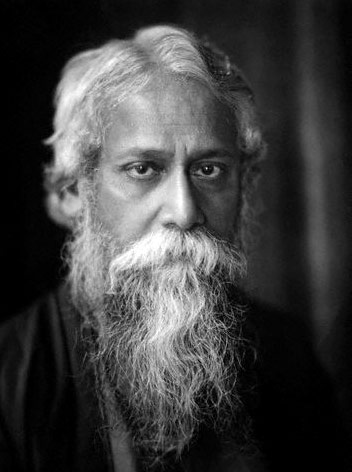
Rabindranath began writing from an early age and impressed with his free-flowing style and spontaneous compositions. He mostly rejected formal schooling; he spent much time being taught at home. In 1878 he travelled to England and sought to study law at University College, London, but he left before finishing the degree.
After returning to India, in 1901, Tagore moved to Shantiniketan to found an ashram which became his focal point for writing and his view on schooling. He chose the name for the ashram – Shantiniketan meaning ‘Abode of Peace.’
“Love is the ultimate meaning of everything around us. It is not a mere sentiment; it is truth; it is the joy that is at the root of all creation.”
– Tagore, Sādhanā : The Realisation of Life (1916)
Friendship with Gandhi
Tagore was firm friends with Gandhi and admired him very much. But, despite this friendship, he could be critical of his views. For example, he disagreed with Gandhi’s views on Swaraj protests and upbraided Gandhi when Gandhi claimed an earthquake was ‘divine retribution for the mistreatment of Dalits in India.’ Yet despite the frequent divergence of opinions, they could admire each other. When Gandhi went on a fast unto death, it was Tagor who was able to persuade Gandhi to give up his fast and look after his health.
Nobel Prize for Literature 1913
In 1913, Tagore was awarded the Nobel Prize for literature for his work ‘ Gitanjali ‘ This made his writings internationally known and his fame spread throughout the world.
“My debts are large, my failures great, my shame secret and heavy; yet I come to ask for my good, I quake in fear lest my prayer be granted.” – Gitanjali
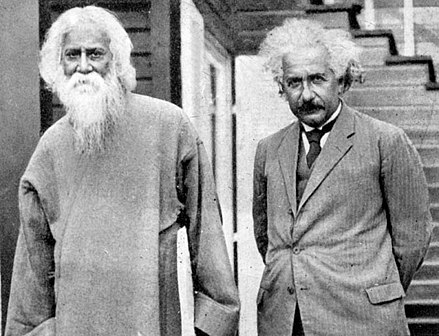
Rabindranath Tagore with Einstein
This gave Tagore the opportunity to travel extensively giving lectures and recitals in many different countries. He also became acquainted with many of the leading cultural contemporaries of the day; this included W.B.Yeats, George Bernard Shaw , Romain Rolland, Robert Frost and Albert Einstein .
Tagore had a great love for nature and many of his poems invoke the simple beauties of the natural world. For Tagore, his religion could be found in the wonders and mysteries of nature – as much as in temples and sacred books.
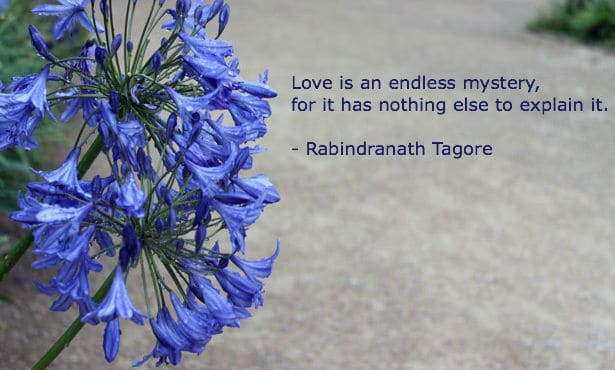
Tagore was a prolific composer of music. He composed over 2,000 songs which have been popularised and sung widely across Bengal. Like his literature, he broke away from classical constraints to offer a great emotive and spiritual appeal. Tagore is unique for being the official composer for the national anthem of two countries – India’s Jana Gana Mana and Bangladesh’s Amar Shonar Bangla .
Tagore was an opponent of British imperialism, though he also felt Indians had a duty to improve their self-education; he said that British rule was partly due to the state India had fallen into. In particular, he was very denigrating about India’s obsession with caste.
‘the ultimate truth in man is not in his intellect or his possessions; it is in his illumination of mind, in his extension of sympathy across all barriers of caste and colour, in his recognition of the world, not merely as a storehouse of power, but as a habitation of man’s spirit, with its eternal music of beauty and its inner light of the divine presence.’ – Tagore, The Poet’s Religion’ in Creative Unity (1922) [ 1 ]
In 1919, Tagore returned his knighthood in protest at the Jallianwala Bagh Massacre, in which many peaceful Indian protesters were killed.
Tagore was a polymath, and towards the end of his life he took up art and also pursued an interest in science. Tagore was also very much an internationalist, criticising nationalism, though also writing songs and articles in support of the general principle of the Indian independence movement.
“Patriotism cannot be our final spiritual shelter; my refuge is humanity. I will not buy glass for the price of diamonds, and I will never allow patriotism to triumph over humanity as long as I live. “
– Rabindranath Tagore
Tagore view on Religion
Tagore had mixed views on religion. He was brought up in a traditional Hindu family and taught to pray and meditate from an early age. He remembers the peace of mind he developed from chanting the Gayatri Mantra, but at the same time was detached from the more formalistic aspects of religion. He tended to see religion as not scriptures and places of worship but the life we lead. As he explained:
“My religion is my life – it is growing with my growth – it has never been grafted on me from outside.” ~ Tagore to Robert Bridges, 8 July 1914.
He was keen to avoid any fanaticism and saw the strength of his own Hindu religion as its ability to see more than one path to the goal. His life-long aspiration was to see a harmony of religions flourish in India – not from mere tolerance but an appreciation of the different merits other religions had.
‘The Idea of freedom to which India aspired was based upon realization of spiritual unity…India’s great achievement, which is still stored deep within her heart, is waiting to unite within itself Hindu, Moslem, Buddhist and Christian, not by force, not by the apathy of resignation, but in the harmony of active cooperation.’ ~ Tagore in Berlin, 1921.
However, he was also critical of the Hindu caste system.
Tagore’s poetry frequently hint at a mystical view of the world.
“In this playhouse of infinite forms I have had my play, and here have I caught sight of him that is formless.” – Gitanjali “The human soul is on its journey from the law to love, from discipline to liberation, from the moral plane to the spiritual.” Sādhanā : The Realisation of Life (1916)
Tagore died on 7th August 1941, after a long and painful illness, aged 80. He died in his family home.
Citation: Pettinger, Tejvan . “ Rabindranath Tagore ”, Oxford, UK www.biographyonline.net , 1st Jun. 2009. Last updated 1 March 2019.
Stories From Tagore
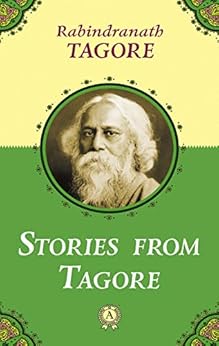
Stories From Tagore at Amazon
The Essential Tagore

The Essential Tagore at Amazon
Related pages

External Links
- Short poems of Rabindranath Tagore
- Tagore Bio at Nobel.org
Rabindranath Tagore
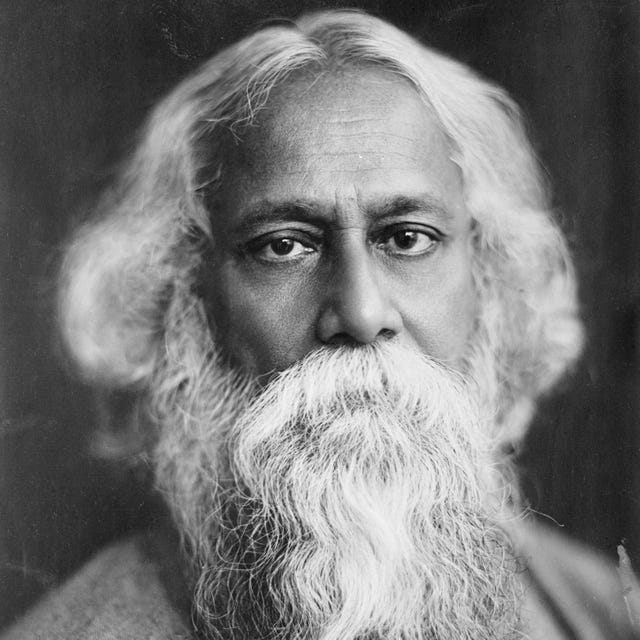
Rabindranath Tagore was a Bengali poet, novelist and painter best known for being the first non-European to be awarded the Nobel Prize for Literature in 1913 with his book Gitanjali, Song Offerings . He was highly influential in introducing Indian culture to the West and is generally regarded as the outstanding creative artist of modern India. He was hailed by W.B Yeats and André Gide.
QUICK FACTS
- Name: Rabindranath Tagore
- Gender: Male
- Best Known For: Rabindranath Tagore was a Bengali poet, novelist and painter best known for being the first non-European to be awarded the Nobel Prize for Literature in 1913.
- Writing and Publishing
- Journalism and Nonfiction
- Fiction and Poetry
- Nacionalities
- Bangladeshi (Bangladesh)
CITATION INFORMATION
- Article Title: Rabindranath Tagore Biography
- Author: Biography.com Editors
- Website Name: The Biography.com website
- Url: https://www.biography.com/authors-writers/rabindranath-tagore
- Access Date:
- Publisher: A&E; Television Networks
- Last Updated: June 24, 2021
- Original Published Date: April 2, 2014
Watch Next .css-smpm16:after{background-color:#323232;color:#fff;margin-left:1.8rem;margin-top:1.25rem;width:1.5rem;height:0.063rem;content:'';display:-webkit-box;display:-webkit-flex;display:-ms-flexbox;display:flex;}

Famous Painters

11 Notable Artists from the Harlem Renaissance

Fernando Botero

Gustav Klimt

The Surreal Romance of Salvador and Gala Dalí

Salvador Dalí

Margaret Keane

Andy Warhol
- Amplification
- Ass Grammar
- Literary Criticism
- Biographies

Rabindranath Tagore’s Contributions to Indian English Literature

Table of Contents
Introduction:
Rabindranath Tagore, a polymath and visionary from India, stands as a towering figure in the realms of literature, art, and philosophy. His influence extends not only across Indian literature but also leaves an indelible mark on the global literary landscape. Tagore’s profound contributions to Indian English literature, in particular, have enriched the literary tradition and transcended cultural boundaries.
Pioneering Indian English Poetry:
“gitanjali” – the song offerings:.
Tagore’s most celebrated work, “Gitanjali” (Song Offerings), is a collection of poems that earned him the Nobel Prize in Literature in 1913. Translated from Bengali to English by the poet himself, these poems express a profound spiritual and philosophical exploration. The verses are characterized by a lyrical beauty that captures the essence of human existence, nature, and the divine. “Gitanjali” not only introduced Tagore to a global audience but also showcased the richness of Indian thought in English literature.
Integration of Indian Themes:
Tagore seamlessly blended Indian themes, imagery, and cultural nuances into his English poetry. The poems reflect his deep engagement with the Indian spiritual tradition, including elements of Hindu mysticism, nature worship, and a universalistic approach that transcends religious boundaries. This fusion of Indian ethos with the English language marked a groundbreaking achievement in the annals of Indian English literature.
Novels and Prose:
“the home and the world”:.
In addition to poetry, Tagore made significant contributions to Indian English literature through novels and prose. “The Home and the World” is a novel that explores complex themes of nationalism, personal freedom, and societal expectations. Written against the backdrop of the Swadeshi Movement, Tagore’s novel provides a nuanced portrayal of characters grappling with the tension between tradition and modernity.
Essays and Reflections:
Tagore’s essays and reflective writings in English, such as “Nationalism” and “Sadhana,” showcase his intellectual depth and engagement with contemporary issues. These works not only contribute to the literary discourse but also offer insights into Tagore’s philosophy on education, art, and the role of the individual in society.
Educational Reforms and Literary Institutions:
Visva-bharati university:.
Tagore’s contributions to literature extended beyond his creative works. He founded Visva-Bharati University in Santiniketan, a center for learning that aimed to harmonize the best of Eastern and Western educational philosophies. This institution became a nurturing ground for artists, writers, and intellectuals, fostering a cultural renaissance that left an enduring impact on Indian English literature.
Literary and Cultural Renaissance:
Tagore’s literary and cultural initiatives, including the establishment of literary magazines like “Sabuj Patra,” played a crucial role in the Bengal Renaissance. By providing a platform for emerging writers and artists, Tagore contributed to the rejuvenation of the literary landscape in Bengal, influencing the trajectory of Indian English literature.
Conclusion:
Tagore’s contributions to Indian English literature are multifaceted and profound, encompassing poetry, novels, essays, and educational reforms. His ability to seamlessly blend Indian themes with the English language, coupled with a universalistic outlook, has left an enduring legacy. Tagore’s impact extends beyond literary circles; it permeates the cultural and intellectual fabric of India and resonates globally, making him a seminal figure in the history of Indian English literature. His work continues to inspire generations, fostering a deeper understanding of the rich tapestry of Indian thought and creativity. 0 0 0.
Analytical Studies of Select Poems of Rabindranath Tagore
Rabindranath Tagore’s Poem ‘Salutation’-An Analytical Study Rabindranath Tagore’s Poem ‘Sit Smiling’-An Analytical Study Rabindranath Tagore’s Poem ‘Ocean of Forms’-An Analytical Study Rabindranath Tagore’s Poem ‘Still Heart’-An Analytical Study Rabindranath Tagore’s Poem ‘Parting Words’-An Analytical Study Rabindranath Tagore’s Poem ‘Threshold’-An Analytical Study Rabindranath Tagore’s Poem ‘Farewell’-An Analytical Study Rabindranath Tagore’s Poem ‘Last Curtain’-An Analytical Study Rabindranath Tagore’s Poem ‘Death’-An Analytical Study Rabindranath Tagore’s Poem ‘Untimely Leave’-An Analytical Study Rabindranath Tagore’s Poem ‘Brink of Eternity’-An Analytical Study Rabindranath Tagore’s Poem ‘Chain of Pearls’-An Analytical Study Rabindranath Tagore’s Poem ‘Endless Time’-An Analytical Study Rabindranath Tagore’s Poem ‘Lost Time’-An Analytical Study Rabindranath Tagore’s Poem ‘Roaming Cloud’-An Analytical Study Rabindranath Tagore’s Poem ‘Let Me Not Forget’-An Analytical Study Rabindranath Tagore’s Poem ‘Lost Star’-An Analytical Study Rabindranath Tagore’s Poem ‘Face to Face’-An Analytical Study Rabindranath Tagore’s Poem ‘Senses’-An Analytical Study Rabindranath Tagore’s Poem ‘Innermost One’-An Analytical Study Rabindranath Tagore’s Poem ‘Maya’-An Analytical Study Rabindranath Tagore’s Poem ‘Stream of Life’-An Analytical Study Rabindranath Tagore’s Poem ‘She’-An Analytical Study Rabindranath Tagore’s Poem ‘Old and New’-An Analytical Study Rabindranath Tagore’s Poem ‘Colored Toys’-An Analytical Study Rabindranath Tagore’s Poem ‘Seashore’-An Analytical Study Rabindranath Tagore’s Poem ‘Passing Breeze’-An Analytical Study Rabindranath Tagore’s Poem ‘Light’-An Analytical Study Rabindranath Tagore’s Poem ‘The Journey’-An Analytical Study Rabindranath Tagore’s Poem ‘Distant Time’-An Analytical Study Rabindranath Tagore’s Poem ‘Silent Steps’-An Analytical Study Rabindranath Tagore’s Poem ‘Where Shadow Chases Light’-An Analytical Study Rabindranath Tagore’s Poem ‘Signet of Eternity’-An Analytical Study Rabindranath Tagore’s Poem ‘Sail Away’-An Analytical Study Rabindranath Tagore’s Poem ‘Beggarly Heart’-An Analytical Study Rabindranath Tagore’s Poem ‘Only Thee’-An Analytical Study Rabindranath Tagore’s Poem ‘Closed Path’-An Analytical Study Rabindranath Tagore’s Poem ‘Give Me Strength’-An Analytical Study Rabindranath Tagore’s Poem ‘Little of Me’-An Analytical Study Rabindranath Tagore’s Poem ‘Free Love’-An Analytical Study Rabindranath Tagore’s Poem ‘Prisoner’-An Analytical Study Rabindranath Tagore’s Poem ‘Who Is This’-An Analytical Study Rabindranath Tagore’s Poem ‘Dungeon’-An Analytical Study Rabindranath Tagore’s Poem ‘Lamp of Love’-An Analytical Study Rabindranath Tagore’s Poem ‘Sleep’-An Analytical Study Rabindranath Tagore’s Poem ‘When Day Is Done’-An Analytical Study Rabindranath Tagore’s Poem ‘Friend’-An Analytical Study Rabindranath Tagore’s Poem ‘Lotus’-An Analytical Study Rabindranath Tagore’s Poem ‘Flower’-An Analytical Study Rabindranath Tagore’s Poem ‘The Boat’-An Analytical Study Rabindranath Tagore’s Poem ‘Patience’-An Analytical Study Rabindranath Tagore’s Poem ‘Strong Mercy’-An Analytical Study Rabindranath Tagore’s Poem ‘Song Unsung’-An Analytical Study Rabindranath Tagore’s Poem ‘Journey Home’-An Analytical Study Rabindranath Tagore’s Poem ‘Purity’-An Analytical Study Rabindranath Tagore’s Poem ‘Little Flute’-An Analytical Study Rabindranath Tagore’s Poem ‘Where The Mind is Without Fear’-An Analytical Study Rabindranath Tagore’s Poem ‘Day After Day He Comes’-An Analytical Study Rabindranath Tagore’s Poem ‘Let Your Work Be’-An Analytical Study Rabindranath Tagore’s Poem ‘I Asked Nothing’-An Analytical Study Rabindranath Tagore’s Poem ‘Why Do You Whisper So Faintly’-An Analytical Study Rabindranath Tagore’s Poem ‘When She Passed by Me’-An Analytical Study Rabindranath Tagore’s Poem ‘I Was Walking by the Road’-An Analytical Study Rabindranath Tagore’s Poem ‘Walk Alone’-An Analytical Study Chief Characteristics of Rabindranath Tagore’s Poetry . 0 0 0
Internet Archive Audio

- This Just In
- Grateful Dead
- Old Time Radio
- 78 RPMs and Cylinder Recordings
- Audio Books & Poetry
- Computers, Technology and Science
- Music, Arts & Culture
- News & Public Affairs
- Spirituality & Religion
- Radio News Archive

- Flickr Commons
- Occupy Wall Street Flickr
- NASA Images
- Solar System Collection
- Ames Research Center

- All Software
- Old School Emulation
- MS-DOS Games
- Historical Software
- Classic PC Games
- Software Library
- Kodi Archive and Support File
- Vintage Software
- CD-ROM Software
- CD-ROM Software Library
- Software Sites
- Tucows Software Library
- Shareware CD-ROMs
- Software Capsules Compilation
- CD-ROM Images
- ZX Spectrum
- DOOM Level CD

- Smithsonian Libraries
- FEDLINK (US)
- Lincoln Collection
- American Libraries
- Canadian Libraries
- Universal Library
- Project Gutenberg
- Children's Library
- Biodiversity Heritage Library
- Books by Language
- Additional Collections

- Prelinger Archives
- Democracy Now!
- Occupy Wall Street
- TV NSA Clip Library
- Animation & Cartoons
- Arts & Music
- Computers & Technology
- Cultural & Academic Films
- Ephemeral Films
- Sports Videos
- Videogame Videos
- Youth Media
Search the history of over 866 billion web pages on the Internet.
Mobile Apps
- Wayback Machine (iOS)
- Wayback Machine (Android)
Browser Extensions
Archive-it subscription.
- Explore the Collections
- Build Collections
Save Page Now
Capture a web page as it appears now for use as a trusted citation in the future.
Please enter a valid web address
- Donate Donate icon An illustration of a heart shape
Rabindranath Tagore : a biography
Bookreader item preview, share or embed this item, flag this item for.
- Graphic Violence
- Explicit Sexual Content
- Hate Speech
- Misinformation/Disinformation
- Marketing/Phishing/Advertising
- Misleading/Inaccurate/Missing Metadata
![[WorldCat (this item)] [WorldCat (this item)]](https://archive.org/images/worldcat-small.png)
plus-circle Add Review comment Reviews
78 Previews
2 Favorites
DOWNLOAD OPTIONS
No suitable files to display here.
PDF access not available for this item.
IN COLLECTIONS
Uploaded by station45.cebu on May 5, 2023
SIMILAR ITEMS (based on metadata)

IMAGES
VIDEO
COMMENTS
Rosona Bichitra by Dhormo Shing Deka. Nobel Bata Bijaye Bharatiya by Bipul Kr. Dihinga. Frenz, H. (editor) (1969), Rabindranath Tagore—Biography, Nobel Foundation, r কৰা হৈছে: 2009-11-26.
ৰবীন্দ্ৰনাথ ঠাকুৰ (ইংৰাজী: Rabindranath Tagore; ৭ মে', ১৮৬১-৭ আগষ্ট, ১৯৪১ ...
নাম (Name) ৰবীন্দ্ৰনাথ ঠাকুৰ (Rabindranath Tagore): জন্ম চন (Date of Birth) ৭ মে, ১৮৬১ চন (7 th ...
রবীন্দ্রনাথ ঠাকুর এফআরএএস (৭ মে ১৮৬১ - ৭ আগস্ট ১৯৪১; ২৫ বৈশাখ ...
Rabindranath Tagore FRAS (/ r ə ˈ b ɪ n d r ə n ɑː t t æ ˈ ɡ ɔːr / ⓘ; pronounced [roˈbindɾonatʰ ˈʈʰakuɾ]; 7 May 1861 - 7 August 1941) was a Bengali poet, writer, playwright, composer, philosopher, social reformer, and painter during the age of Bengal Renaissance. He reshaped Bengali literature and music as well as Indian art with Contextual Modernism in the late 19th and ...
Rabindranath Tagore died on August 7, 1941. From Nobel Lectures, Literature 1901-1967, Editor Horst Frenz, Elsevier Publishing Company, Amsterdam, 1969. Acknowledgement: This autobiography/biography was written at the time of the award and first published in the book series Les Prix Nobel. It was later edited and republished in Nobel Lectures.
In 1891 Tagore went to East Bengal (now in Bangladesh) to manage his family's estates at Shilaidah and Shazadpur for 10 years. There he often stayed in a houseboat on the Padma River (the main channel of the Ganges River), in close contact with village folk, and his sympathy for them became the keynote of much of his later writing.Most of his finest short stories, which examine "humble ...
Rabindranath Tagore died on August 7, 1941. From Nobel Lectures, Literature 1901-1967, Editor Horst Frenz, Elsevier Publishing Company, Amsterdam, 1969. This autobiography/biography was written at the time of the award and first published in the book series Les Prix Nobel . It was later edited and republished in Nobel Lectures.
Short Biography Rabindranath Tagore. Rabindranath was born on 7 May 1861 Calcutta. His father Debendranath Tagore was a leading light in the Brahmo Samaj - a reforming Hindu organisation which sought to promote a monotheistic interpretation of the Upanishads and move away from the rigidity of Hindu Orthodoxy which they felt was holding back ...
Tagore was born in the Jorasanko district of Kolkata (Calcutta) on 7 May 1861. He was the youngest child of Debendranath Tagore (1817-1905) and Sarada Devi (1826-1875). Originally from Jessore, now in Bangladesh, the Tagore (Thakur in Bengali) family belonged to a Brahman subcaste known as Pirali.
Rabindranath Tagore was a Bengali poet, novelist and painter best known for being the first non-European to be awarded the Nobel Prize for Literature in 1913.
Lakshminath Bezbarua (Assamese: [lɔkʰminatʰ bɛzbɔɹuwa]]; 14 November 1864 - March 26,1938) was an Assamese poet, novelist and playwright of modern Assamese literature.He was one of the literary stalwarts of the Jonaki Era, the age of romanticism in Assamese literature when through his essays, plays, fiction, poetry and satires, he gave a new impetus to the then stagnating Assamese ...
Tagore's house in Shelaidaha, Bangladesh. The works of Rabindranath Tagore consist of poems, novels, short stories, dramas, paintings, drawings, and music that Bengali poet and Brahmo philosopher Rabindranath Tagore created over his lifetime. Tagore's literary reputation is disproportionately influenced by regard for his poetry; however, he ...
Poems - Rabindranath drew inspiration from ancient poets like Kabir and Ramprasad Sen and thus his poetry is often compared to the 15th and 16th Century works of classical poets. By infusing his own style of writing, he made people to take note of not only his works but also the works of ancient Indian poets. Interestingly, he penned down a poem in 1893 and addressed a future poet through ...
Rabindranath Tagore, born May 7, 1861, in Kolkata, India—died August 7, 1941. Bengali poet, short-story writer, music composer, playwright, novelist, and painter brought new prose and verse forms and colloquial language into Bengali literature, freeing it from standard methods based on classical Sanskrit.
Rabindranath Tagore; a biography by Kripalani, Krishna, 1907-1993. Publication date 1962 Topics Tagore, Rabindranath, 1861-1941, Tagore, Rabindranath, (1861-1941) Publisher New York, Oxford University Press Collection inlibrary; printdisabled; claremont_school_of_theology; internetarchivebooks Contributor Internet Archive
இரவீந்தரநாத் தாகூர் (Rabindranath Tagore) வங்காள மொழி: রবীন্দ্রনাথ ঠাকুর ...
By providing a platform for emerging writers and artists, Tagore contributed to the rejuvenation of the literary landscape in Bengal, influencing the trajectory of Indian English literature. Conclusion: Tagore's contributions to Indian English literature are multifaceted and profound, encompassing poetry, novels, essays, and educational reforms.
Sharmila Tagore (also known as Begum Ayesha Sultana; born 8 December 1944) is an Indian actress primarily known for her work in Hindi and Bengali films. Regarded among the greatest actresses in the history of Indian cinema, Tagore is a recipient of two National Film Awards, a Filmfare Award and the Filmfare Lifetime Achievement Award for her contributions to Hindi cinema.
Oxford University Press, 2004 - Biography & Autobiography - 104 pages. Nobel Prize laureate Rabindranath Tagore (1861-1941) is known to us today primarily as a poet and littérateur. Not many people, though, are aware of the vital significance of his efforts in the field of education and rural reconstruction. He loved the people of his country ...
The Tagore family (also spelled as Thakur) [note 1] [1] has been one of the leading families of Kolkata, India, and is regarded as one of the key influencers during the Bengali Renaissance. The family has produced several people who have contributed substantially in the fields of business, social and religious reformation, literature, art and ...
Rabindranath Tagore : a biography by Dasgupta, Uma. Publication date 2004 Topics Tagore, Rabindranath, 1861-1941, Authors, Bengali -- Biography Publisher New Delhi ; New York : Oxford University Press Collection inlibrary; printdisabled; internetarchivebooks Contributor Internet Archive
from 1933 until Tagore's death in 1941. His book Rabindranath Tagore - a Biography is a rich contribution to Tagore research. This is a chronological study of Tagore's life by analyzing his philosophy and activities in detail. Rathindranath Tagore, the son of the poet, is the author of On the Edges of Timewhich is a biography of Tagore and